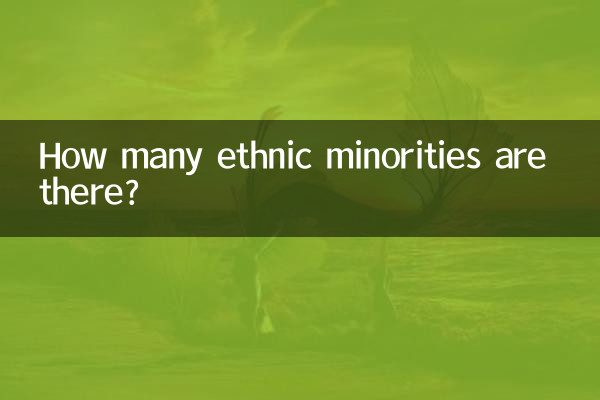How many ethnic minorities are there in China? Discover multicultural treasures
China is a multi-ethnic country with rich and colorful culture and history. According to official statistics, China has a total of56 ethnic groups, among which the Han nationality is the main ethnic group and the other 55 are ethnic minorities. These ethnic minorities have their own characteristics in language, clothing, customs and traditions, and together they constitute the multicultural picture of the Chinese nation. Below is detailed data and analysis on China’s ethnic minorities.
1. Population distribution of ethnic minorities in China

According to the latest census data, the total population of ethnic minorities in China is approximately 125 million, accounting for 8.89% of the total population. The following are the 10 most populous ethnic minorities and their population data:
| Ranking | nationality | Population (10,000) | Main distribution areas |
|---|---|---|---|
| 1 | Zhuang | 1956 | Guangxi, Yunnan |
| 2 | Hui | 1138 | Ningxia, Gansu, Henan |
| 3 | Manchu | 1042 | Liaoning, Heilongjiang |
| 4 | Uighur | 1006 | Xinjiang |
| 5 | Miao | 942 | Guizhou, Hunan, Yunnan |
| 6 | Yi nationality | 871 | Sichuan, Yunnan |
| 7 | Tujia | 835 | Hunan, Hubei, Guizhou |
| 8 | Tibetan | 628 | Tibet, Qinghai, Sichuan |
| 9 | Mongolian | 598 | Inner Mongolia, Liaoning |
| 10 | Dong people | 287 | Guizhou, Hunan |
2. Languages and scripts of ethnic minorities
China has a wide variety of ethnic minority languages, and some ethnic groups have their own writing systems. The following is the language and writing situation of some ethnic minorities:
| nationality | language family | Is there text | representative text |
|---|---|---|---|
| Uighur | Turkic language family | yes | Arabic alphabet Uyghur |
| Tibetan | Sino-Tibetan language family | yes | Tibetan |
| Mongolian | Mongolian language family | yes | Traditional Mongolian, Cyrillic Mongolian |
| Zhuang | Zhuang-Dong language family | yes | Zhuang (Latin alphabet) |
| Yi nationality | Sino-Tibetan language family | yes | Yi |
3. Traditional festivals and customs of ethnic minorities
Each ethnic minority has unique festivals and customs. Here are several famous ethnic minority festivals:
4. Economic and social development of ethnic minorities
The Chinese government attaches great importance to the development of ethnic minority areas and has implemented a series of support policies, including investment in education, medical care, infrastructure and other fields. The following is the economic data of some ethnic minority autonomous regions:
| autonomous region | GDP (100 million yuan) | Main industries |
|---|---|---|
| Xinjiang Uygur Autonomous Region | 17741 | Energy, agriculture, tourism |
| Tibet Autonomous Region | 2080 | Tourism, agriculture and animal husbandry |
| Inner Mongolia Autonomous Region | 20514 | Coal, animal husbandry, rare earths |
| Guangxi Zhuang Autonomous Region | 24740 | Agriculture, manufacturing, tourism |
5. Summary
China's 55 ethnic minorities are an important part of Chinese culture. Their rich history, language and traditions have added unique charm to the Chinese nation. With the support of national policies, the development prospects of ethnic minority areas are broad, and diverse cultures will continue to shine on the land of China.

check the details

check the details